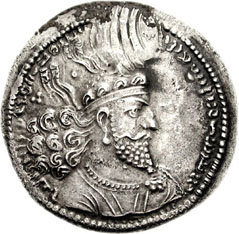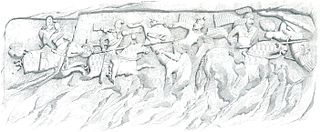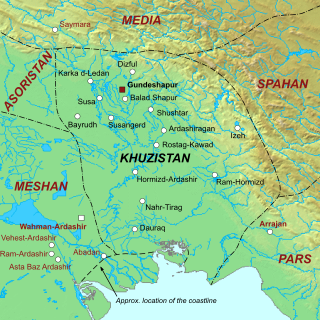
Khosrow I, traditionally known by his epithet of Anushirvan, was the Sasanian King of Kings of Iran from 531 to 579. He was the son and successor of Kavad I.

Hormizd-Ardashir, better known by his dynastic name of Hormizd I, was the third Sasanian King of Kings (shahanshah) of Iran, who ruled from May 270 to June 271. He was the third-born son of Shapur I, under whom he was governor-king of Armenia, and also took part in his father's wars against the Roman Empire. Hormizd I's brief time as ruler of Iran was largely uneventful. He built the city of Hormizd-Ardashir, which remains a major city today in Iran. He promoted the Zoroastrian priest Kartir to the rank of chief priest (mowbed) and gave the Manichaean prophet Mani permission to continue his preaching.

Yazdegerd I was the Sasanian King of Kings of Iran from 399 to 420. A son of Shapur III, he succeeded his brother Bahram IV after the latter's assassination.

Shapur I was the second Sasanian King of Kings of Iran. The dating of his reign is disputed, but it is generally agreed that he ruled from 240 to 270, with his father Ardashir I as co-regent until the death of the latter in 242. During his co-regency, he helped his father with the conquest and destruction of the Arab city of Hatra, whose fall was facilitated, according to Islamic tradition, by the actions of his future wife al-Nadirah. Shapur also consolidated and expanded the empire of Ardashir I, waged war against the Roman Empire, and seized its cities of Nisibis and Carrhae while he was advancing as far as Roman Syria. Although he was defeated at the Battle of Resaena in 243 by Roman emperor Gordian III, he was the following year able to win the Battle of Misiche and force the new Roman Emperor Philip the Arab to sign a favorable peace treaty that was regarded by the Romans as "a most shameful treaty".
Sasan, considered the eponymous ancestor of the Sasanian Dynasty in Persia, was "a great warrior and hunter" and a Zoroastrian high priest in Pars. He lived sometime near the fall of the Arsacid (Parthian) Empire in the early 3rd century CE.

Touraj Daryaee is an Iranian Iranologist and historian. He currently works as the Maseeh Chair in Persian Studies and Culture and the director of the Dr. Samuel M. Jordan Center for Persian Studies at the University of California, Irvine.

Mazun was a Sasanian province in Late Antiquity, which corresponded to modern-day Bahrain, Qatar, United Arab Emirates, and the northern half of Oman. The province served as a Sasanian outpost and played an important role in the Sasanian efforts to gain control over the Indian Ocean trade, and to establish their dominance in the wealthy regions of Hadramaut and Yemen.

The Sasanian Empire, officially known as Eranshahr was the last Iranian empire before the early Muslim conquests of the 7th–8th centuries AD. Named after the House of Sasan, it endured for over four centuries, from 224 to 651 AD, making it the longest-lived Persian imperial dynasty. The Sasanian Empire succeeded the Parthian Empire, and re-established the Persians as a major power in late antiquity alongside its neighbouring arch-rival, the Roman Empire.

Pabag, was an Iranian prince who ruled Istakhr, the capital of Pars, from 205 or 206 until his death sometime between 207–210. He was the father, stepfather, grandfather, or father-in-law of Ardashir I, the founder of the Sasanian Empire. He was succeeded by his eldest son Shapur.

The Battle of Hormozdgan was the climactic battle between the Arsacid and the Sasanian dynasties that took place on April 28, 224. The Sasanian victory broke the power of the Parthian dynasty, effectively ending almost five centuries of Parthian rule in Iran, and marking the official start of the Sasanian era.
The modern Persian name of Iran (ایران) means "the land of Aryans". It derives immediately from the 3rd-century Sasanian Middle Persian ērān, where it initially meant "of the Iranians", but soon also acquired a geographical connotation in the sense of "(lands inhabited by) Iranians". In both geographic and demonymic senses, ērān is distinguished from its antonymic anērān, meaning "non-Iran(ian)".
Šahrestānīhā ī Ērānšahr is a surviving Middle Persian text on geography, which was completed in the late eighth or early ninth centuries AD. The text gives a numbered list of the cities of Eranshahr and their history and importance for Persian history. The text itself has indication that it was also redacted at the time of Khosrow II in 7th century as it mentions several places in Africa and Persian Gulf conquered by the Sasanians.

The Sasanian dynasty was the house that founded the Sasanian Empire, ruling this empire from 224 to 651 AD in Persia. It began with Ardashir I, who named the dynasty as Sasanian in honour of his grandfather, Sasan, and after the name of his tribe.

Mihr-Narseh, was a powerful Iranian dignitary from the House of Suren, who served as minister of the Sasanian shahanshahs Yazdegerd I, Bahram V, Yazdegerd II and Peroz I. According to the Iranologist Richard N. Frye, Mihr-Narseh was the "prototype of the later Islamic grand vizier."
The Sasanian navy was the naval force of the Sasanian Empire active since its establishment. It operated in the Persian Gulf, the Arabian Sea, the Red Sea, and briefly in the Mediterranean Sea.

Pars was a Sasanian province in Late Antiquity, which almost corresponded to the present-day province of Fars. The province bordered Khuzestan in the west, Kirman in the east, Spahan in the north, and Mazun in the south.

Shapur was an Iranian prince, who was the penultimate King of Persis from 207–210 to 211/2. He was succeeded by his younger brother Ardashir I, who founded the Sasanian Empire.

The Kings of Persis, also known as the Darayanids, were a series of Persian kings, who ruled the region of Persis in southwestern Iran, from the 2nd century BCE to 224 CE. They ruled as sub-kings of the Parthian Empire, until they toppled them and established the Sasanian Empire. They effectively formed some Persian dynastic continuity between the Achaemenid Empire and the Sasanian Empire.

Khuzistan or Huzistan was a Sasanian province in Late Antiquity, which almost corresponded to the present-day province of Khuzestan. Its capital was Gundeshapur. During the late Sasanian era, the province was included in the southern quadrant (kust) of Nemroz.
















